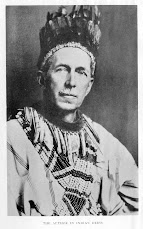By Audrey Fullerton
From the Canadian Magazine, December 1916
Even in those early days when people lived
more simply than now, and knew nothing of booms or bargains, the well-being of
society, in Canada as everywhere else, rested in some measure upon the gentle
art of advertising. It is no new invention of these latter times that men
should be told through the public prints that their various wants may be supplied,
at place and price indicated; nor is it a new thing that men who are prepared
to render services should seek to convince their neighbours that they need such
services. All the psychology and utility of advertising, as known to us of the
present day in a hundred and one complicated forms, existed in embryo a long
time ago: in proof of which one may look at the ways of society and the wiles
of merchantmen in the good old city of Halifax from, say, 1770 to 1814.
Eighteenth-century
cities in Canada were not many or large, but after their kind they took
colour, just as cities do to-day, from their business houses and their ways of
buying and selling. Halifax had as picturesque a row of shops, and as notable a
roll of shop-keepers, as ever a city had, and it is a pity that something of
that old-time merchant flavour could not have been preserved to this more busy day. But the Halifax tradesmen of a
hundred years ago announced their wares in The Halifax Royal Gazette, and otherwise, and their advertisements—more
enduring literature than many of the modern bestsellers—still remain as
reflections of the life and social order that gave them birth.
There was a certain
barber in Halifax in 1789, George Clarke by name, who believed in letting his light shine!
Hairdressing in those days of wigs and curls was a quite different matter from
twentieth-century barbering and since there were no barbers’ unions to regulate
the trade, the way was open both to cultivate a really professional pride in it
and to make a strong bid for custom, brother friseurs notwithstanding. On the
first day of December, perhaps in view of a general sprucing-up for Christmas
among the dandies of the town, Barber Clarke advertised himself and his work
thus adroitly:
“The
subscriber, hair dresser to ladies and gentlemen, begs leave to acquaint his
friends and the public, that he now lives at the north-west corner of the Grand
Parade, and informs them that he follows his profession with punctuality (as
usual), and flatters himself that notwithstanding he is a Nova Scotian, his
performance will be at least equal that of many German, London, Dublin, or Cork
Court friseurs! And altho’ he is possessed of the greatest share of customers,
that his diligence and activity in business entitles him to more encouragement
from the old standing inhabitants than he now receives. He begs leave to
acquaint the public that it is not his intention to gain their custom and approbation
otherwise than by his industry, although many have succeeded by flattery and
misrepresentation.”
The nearest approach to
modern department-store advertising was that of Anthony Henry, in 1782. Henry
was King’s Printer as well as merchant, and for forty years the publisher of The Gazette; and it may be that his familiar
knowledge of printer’s ink had something to do with his generous use of it in
the interests of trade. His shop must have been a delightful place to visit,
and a reasonably satisfying one; for its wares were very miscellaneous. One
naturally pictures the good folk of Halifax flocking to it in response to the
following announcement:
“Just imported from London, in the ship Adamant,
Capt. Wyatt, master, and to be sold by Anthony Henry, a general assortment of
the best stationery and books; Bohea, Souchong, Green, and Hyson tea; loaf
sugar and molasses; wax and tallow candles; men’s best shoes and pumps; women’s
everlasting and sarsenet shoes; an assortment of pickles, in cases; fiddle
strings; printing types, for marking linen; an assortment of curious prints;
magick lanthorns and slides; scented hair powder; Jarr raisons; Valentia
almonds, shell’d and unshell’d; candied citron and orange; troffels; macaroni;
morels; vermacella; pearl barley; almonds; comfits, earianther do., carraway,
and other confectionary, sorted; cinnamon, cloves, nutmeg and mace, &c.,
&c.
‘‘Parlour and Franklin’s open stoves; Irish Rose
butter; French and Scotch barley; split peas; a variety of telescopes, opera and
reading glasses; acorn microscopes; with a variety of other articles. All will
be sold at the lowest rates for cash.”
Not so clever or
encyclopedic an advertiser as either of these tradesmen was Robert Walker, who
combined shoemaking, gardening, and philosophy. He was a flower-lover, and
seems to have made some effort to encourage gardening throughout the town. This
brief advertisement is on record:
‘‘A great variety of flower roots and seeds,
warranted good, to be sold by Robert Walker, nearly opposite to Hestorman’s.”
But Walker, perhaps
Canada’s first seedsman, was himself more interesting than his business. He
was something of a cynicist, and delighted in his later years to pull down the
pride of his fellow townsmen of the younger generation by telling them tales of
how humbly their fathers had begun in life.
A mathematical school
was advertised in 1795. It was a night-school, with hours from six to nine
o’clock, and evidently was intended for the young men who were otherwise engaged
through the day.
Old Halifax had a gay
and varied social life, as befitted the capital and garrison city. Banquets,
balls, and theatricals were frequent, and some very pretentious stage-play was
put on the boards, under high patronage. The amusement bulletins had these,
among other notices:
“Grand Theatre, Argyle Street, 26 Feb. (1789),
‘Merchant of Venice,’ and the farce of ‘The Citizen.’ The characters by
gentlemen of the navy, army, and town. Tickets to be had of Mr. Howe, printer.
Boxes, 5s.; Pit, (first), 3s.; second pit. 2s. The doors to be open at 6
o’clock, and the curtain drawn up precisely at 7.”
‘‘Tuesday, 10 March. New Grand Theatre. ‘Beaux
Strategen’ and ‘The Deuce is in Him.’ It is particularly requested the ladies
will dress their heads as low as possible, otherwise the persons sitting behind
cannot have a view of the stage. The ladies and gentlemen are desired to give
directions to their servants, when they come to take them from the theatre, to
have their horses’ heads towards the parade.”
“Wednesday, 13 Jan’y., 1795. Halifax Theatre. By
the desire of H.R.H. Prince Edward. ‘Love a la Mode’ and ‘The Agreeable
Surprise’. No children in laps to be admitted.”
Fashionable conveyance
to and from the playhouses and other social gathering-places was by sedan
chairs and coaches. In 1793 and 1794 sedan chairs were advertised to stand for
hire in Barrington Street, at charges of from one shilling to one and six-pence. “On Sunday, one-eighth of a dollar
to church.” This mode of travel, however, gave way in a few years to hackney
coaches, one operator of which advertised in January, 1811, as follows:
“Under
the patronage of His Excellency Sir George Prevost, Lieut.-Governor and
Commander-in-Chief:—W. Madden begs leave to acquaint the Ladies and Gentlemen
of Halifax, that he has fitted up Three Carriages, which he will send to the
Stand for their accommodation, on Monday next, 21st instant, on the following
reasonable rates: To any part of the Town, for one person, 2s. 6d.—for two, 3s.
6d.—for four, 6s. 3d. . . . When kept in waiting longer than one-quarter of an
hour, to pay at the rate of 5s. 6d. per hour. . : . All jobs about town after Dark to pay
one-third more fare. . .”
But Halifax’s social
life was not all pleasant and rose-tinted. This, on January 19, 1779, shows
another and a sorrier phase of it:
“To
be sold, an able negro wench, about 21 years of age, who is capable of performing
both town and country house work. She is an exceeding good cook. For further
particulars inquire of the printer.”
In the same year another
citizen advertised a reward of twenty dollars for information of a negro
man-servant who had run away from him.
If the commercial
advertising of a hundred years ago was ordinarily heavier and duller than that
of today, some of the Government notices at least were more lively than either
departments of state or city councils now send out. Facetiously worded
allurements were thus held out to young Haligonians in May, 1813, by the Navy
Office:
“What
Should Sailors do on Shore, while King, Country and Fortune point to the
Ocean!—His Majesty’s Schooner PICTOU, of 12 guns, commanded by Lieut. Stephens,
as fine a vessel of her size as ever floated on salt water, wants a few jolly,
spirited fellows to complete her complement for a short
cruise, who may all fairly expect to dash in Coaches on their return, as well as other folks. Apply on board, at the Navy Yard.”
Had there been even more
advertising in pioneer Halifax, it would be possible, with some imagination, to
reconstruct the general life of the old citadel town. Such announcements,
however, as these, being fair and truthful samples, give hints of the close and
interesting relation that existed between business and society then, as now.
They bought and sold, made and asked special prices, invited custom and gave or
withheld it, after the same very human way as do we to-day, but with the mellow
colouring of a hundred years ago.





No comments:
Post a Comment